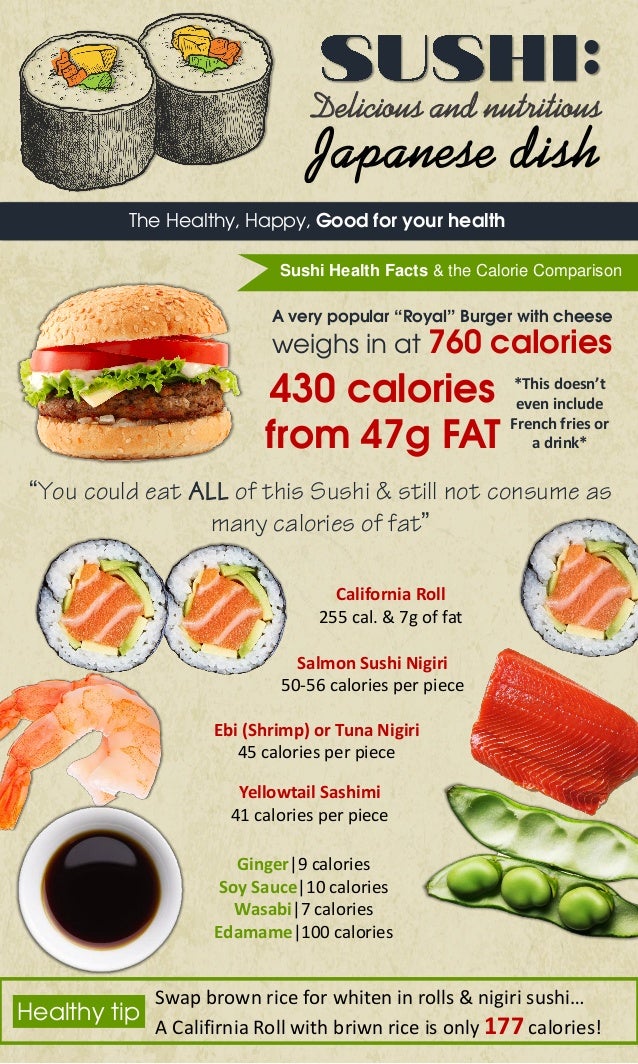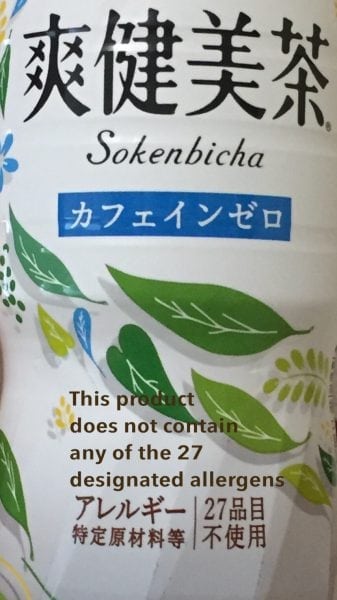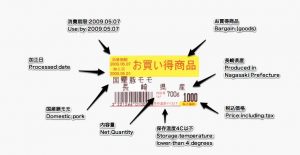44 how to read japanese food labels
The Ultimate Guide to Reading Food Labels in Japan Most labels similar to this type will then list total protein (たん白質), fat ( 脂質), carbohydrates (炭水化物), and sodium (ナトリウム), and some will list sugar, but many count sugar under the "carbohydrate" category and don't always split them so you can see how much of the carbs are sugars. It varies though. Food labelling | New Zealand Government Food labelling. Food labels help you make informed choices about the products you buy. The Ministry for Primary Industries website has information about food labelling. Find out what each part of the label means and what to do if you find a problem with a food label. How to read food labels. [L1]
Japanese Supermarket Guide: Must-Know Phrases, Food Label Breakdown ... In Japan, it's pretty easy to find regular cow milk (牛乳), soy milk (豆乳), and almond milk (アーモンドミルク). Cow milk in Japan comes in a wide variety, from those fortified with iron (鉄) or calcium (カルシウム), to low-fat products (低脂肪). To check exactly how much fat your milk has, look out for the fat content label (乳脂肪分).

How to read japanese food labels
HOW TO: Find Allergy-Friendly Food in Japan 1. Prepackaged processed food (chips, orange juice cartons, cookies, etc.) 2. Canned or Jarred processed food (jam, baby food, etc.) If a product contains a miniscule amount of one of the seven allergens it will be marked; however, if it contains just a few milligrams per kilogram it will not be marked. Reading food labels | Tasmanian Department of Health Download the Reading Food Labels fact sheet Look for the stars The Health Star Rating is a quick and easy way to compare similar packaged foods, for example breakfast cereals. The Health Star Rating system is not intended for fresh unpackaged foods like fruit and vegetables. These foods are recommended to be a main part of family eating. Tokyo Guide: How To Read Japanese Food Labels Micronutrients are usually expressed using English letters, numbers and katakana so should be pretty easy to understand. The main difference is that many labels, especially in the US, measure in percent of daily recommended values, whereas Japan does it in straight milligrams. Generally with micronutrients the more there are the better.
How to read japanese food labels. Reading Japanese Food Labels | JustBento Reading Japanese Food Labels. Submitted by anon. on Sat, 2009-09-05 07:24. I live in Japan and have trouble reading and understanding everything on food labels. Do you know if partially hydrogenated oils are used in Japanese foods, such as packaged cookies? Do you know what the word for it or "trans fat" is in Japanese or how to write it? English translation of Japanese food label (soy milk) | Reading food ... How to read and understand food and nutrition labels in Japan. S Surviving in Japan Japan Guides Peaches Blueberry Seeds Mountain Japanese Vegetables Fruit Health Japanese Bayberries also known as myrica rubra, mountain peaches, and yangmei. Sweet, a little sour, with seeds in the middle. K Kylene O'Connor Okinawan Market Foods Go To Japan Beginners Guide to Supermarket Shopping in Japan - GaijinPot Howard Japansays: October 30, 2014 at 8:08 am. 「Firstly, most supermarkets in Japan are actually better described as grocery stores, in that they exclusively sell food. Don't go in expecting to buy bubble bath, a razor and a few cheap t-shirts because most supermarkets just won't stock these kinds of items.」. Japanese Decoded: Nutrition Labels - Savvy Tokyo Below is the back of a bag of rice crackers (senbei) carrying a standard Japanese nutrition label. On the top left, we see the nutritional information (栄養成分表, eiyou seibun you), which contains all the basic nutrition facts about the product, such as grams of carbohydrates, protein, and fat.
How to Identify Japanese Pottery Porcelain Marks - Hunker Unless you're familiar with the Japanese language, identifying Japanese pottery and porcelain marks can be a daunting task. Hidden within the kanji-- the characters -- on the bottom of the piece you will typically find the production region, a specific kiln location, a potter's name, and sometimes a separate decorator's identity.But, at times only generic terms were recorded, and tracking down ... Quick Guide: Know And Understand Food Allergies In Japan These are typically the "emergency reaction" foods, that can cause immediate anaphylaxis and should be avoided at all costs by those with allergies. えび ebi shrimp. かに kani crab. 小麦 komugi wheat. そば (蕎麦) soba buckwheat. 卵 tamago egg/egg derivatives. 乳 / 牛乳 nyu/gyunyu milk/dairy derivatives. 落花生 rakkasei ... How to Read Japanese Nutrition Labels - Japan Living Guide To this end, you should check the amount of carbs and sugar contained in your food and beverages. On a nutrition label, "carbohydrate" means the sum of "sugar" and "dietary fiber". Sugars Sugars (糖質, toshitsu) are contained in cereals, potatoes, rice, sugar, etc. They are nutrients which are our energy sources. How to Read Japanese Food Label | Coto Language Academy Guide to Your Japanese Food Labels Guide to your Japanese Bathtubs Vocabulary: エネルギー (enerugi-) Energy たんぱく質 (tanpakushitsu) Protein 脂質 (shishitsu) Fat 炭水化物 (tansuikabutsu) Carbohydrate 糖質 (toushitsu) Sugar 食物繊維 (shokubutsuseni) Fiber 食塩 (shokuen) Sodium 低カロリー (teikarori-) Low Calorie 高たんぱく質 (koutanpakushitsu) High Protein 無糖 (mutou) No Sugar
The Ultimate Guide to Reading Food Labels in Japan Apr 25, 2015 - How to read and understand food and nutrition labels in Japan. Apr 25, 2015 - How to read and understand food and nutrition labels in Japan. ... Well, today it is. But it wasn't always one of the Japanese colors. The Japanese people could always see the color green (o. Jadayah Spencer. Apartment Color Study. Eurotrip. Munich ... Types and Grades of Beef and What Beef Labels Mean Apr 10, 2022 · Wagyu translates to "Japanese beef cattle" and includes four breeds. The meat has a more intense marbling than Angus, with a distinguished texture and flavor, and it's some of the most expensive beef in the world. Kobe beef comes from a specific breed of cattle (Tajima, or Japanese Black) raised in Japan's Hyogo prefecture. Despite the legends ... Food Allergies in Japan: How to Read Japanese Food Labels The complete list of twenty additional allergens is as follows: 1. Abalone 2. Apple 3. Banana 4. Beef 5. Cashew Nut 6. Chicken 7. Gelatin 8. Kiwi 9. Mackerel 10. Matsutake mushroom 11. Orange 12. Peach 13. Pork 14. Salmon 15. Salmon roe 16. Sesame 17. Soy 18. Squid 19. Yam 20. Walnut Reading Nutritional Labels in Japan vs the US - Kokoro Care Packages This one is easy to identify because the number is followed by kcal. たんぱく質 (tanpakushitsu) is equivalent to protein. 脂質 (shishitsu) is total fat and is calculated in grams (just as it is in the United States). 炭水化物 (tansuikabutsu) is carbohydrates.
What's on a food label | NSW Food Authority Ingredients. Ingredients must be listed in order by weight, with the largest ingredient first. The sub-ingredients of compound ingredients must also be listed and declared if they require a mandatory declaration, such as allergens. If the compound makes up 5% or more of the product, all sub-ingredients must be listed.
Labeling of Beer|Brewery Convention of Japan Currently, each beer manufacturer observes labeling legislation based on the above Cord. In July 1995, the Product Liability (PL) Law came into effect. This was an attempt to systematically protect consumers from accidents involving products. Though information had previously been shown on labels concerning product handling, unified labeling ...
Kanji Practice Worksheet Free Download: JLPT N2 -Unit 3: Food Labels ... Reading food labels in Japan is always challenging for beginners. Master the kanjis on food labels with our kanji practice worksheet. ... In this unit, we sort out some common kanji to help you understand the information written on Japanese food labels and packaging. To learn more N2 kanji related to themes such as "Food", "Advertising ...
How to Read a Dog Food Label - American Kennel Club The quantity listed on the label tells you how much of the food is in the container. This may be measured by weight, liquid measure, or by count. Products can vary in density (think wet food vs....
How to read food labels in Japan - Japan Retail News - Inside consuming Japan - Trends, Products ...
How to read a label | NSW Food Authority The country or countries where a food was grown, manufactured or packaged must appear on the label. Directions for use Directions for use must be included when there are health and safety reasons for doing so. Alcohol Alcohol labels must state the number of standard drinks and % of alcohol, and comply with general labelling laws.
How to read seafood labels in Japan - PLAZA HOMES You often see the lables of "生食用" (for raw food), "刺身用" (for sashimi), "加熱用" (for heating), "焼き魚用" (for grill) on seafood packaging in Japanese supermarkets. Here we explain the differences when purchasing the perfect seafood for your meal. For raw food (Namashokuyou) This lable literally means that you can eat it raw.
Is BPA-Free Plastic Safe? Get the Facts. - Science Sep 13, 2018 · Mounting public pressure pushed companies to move away from BPA, leading to an influx of products touting their “BPA-free” status. But the FDA only officially bans the compound from use in ...

Japanese Stickers + Korean Stickers | Korean stickers, Aesthetic stickers, Bullet journal stickers
How To Read Sake Label - Steamy Kitchen Recipes Giveaways On the front, you'll see "Takasago" on the left bottle. That happens to be the brewery's name. If you're not familiar with Japanese or brewery names, this might be difficult to spot. But what's important on the front of the label is the GRADE of sake. For premium, artisan sake, look for the words "Junmai" or "Junmai Daiginjo."
Expiry dates | The Japan Times It's the four characters in front of the date. It means "limit for consumption" and is equivalent to the "use by" wording on food labels in English. "Sh ō hi kigen" is used for highly perishable...
Food Allergies in Japan: How to Enjoy Traveling Safely with a Food ... The food labeling system in Japan has different requirements and only 7 core allergens are required to be labelled. A list of allergenic foods in Japan is: eggs, milk, wheat, buckwheat, peanuts, shrimp and crab. Some allergens can be listed using very different forms, such as 落花生 and ピーナッツ - both of which refer to peanuts.

The Ultimate Guide to Reading Food Labels in Japan | Surviving in Japan: (without much Japanese ...
Reading Japanese Food Labels - Allergens and Tips Food labels are 食品表示 (しょくひんひょうじ shokuhin hyou ji) in Japanese. Let's take a look at a food label before going on into the various parts of Japanese food labels and how to read them. Below is the label to a popular brand of barley (mugi) tea. Lots of text here, but if you look closely the label actually consists of 2 parts.
Tokyo Guide: How To Read Japanese Food Labels Micronutrients are usually expressed using English letters, numbers and katakana so should be pretty easy to understand. The main difference is that many labels, especially in the US, measure in percent of daily recommended values, whereas Japan does it in straight milligrams. Generally with micronutrients the more there are the better.
Reading food labels | Tasmanian Department of Health Download the Reading Food Labels fact sheet Look for the stars The Health Star Rating is a quick and easy way to compare similar packaged foods, for example breakfast cereals. The Health Star Rating system is not intended for fresh unpackaged foods like fruit and vegetables. These foods are recommended to be a main part of family eating.
HOW TO: Find Allergy-Friendly Food in Japan 1. Prepackaged processed food (chips, orange juice cartons, cookies, etc.) 2. Canned or Jarred processed food (jam, baby food, etc.) If a product contains a miniscule amount of one of the seven allergens it will be marked; however, if it contains just a few milligrams per kilogram it will not be marked.










Post a Comment for "44 how to read japanese food labels"